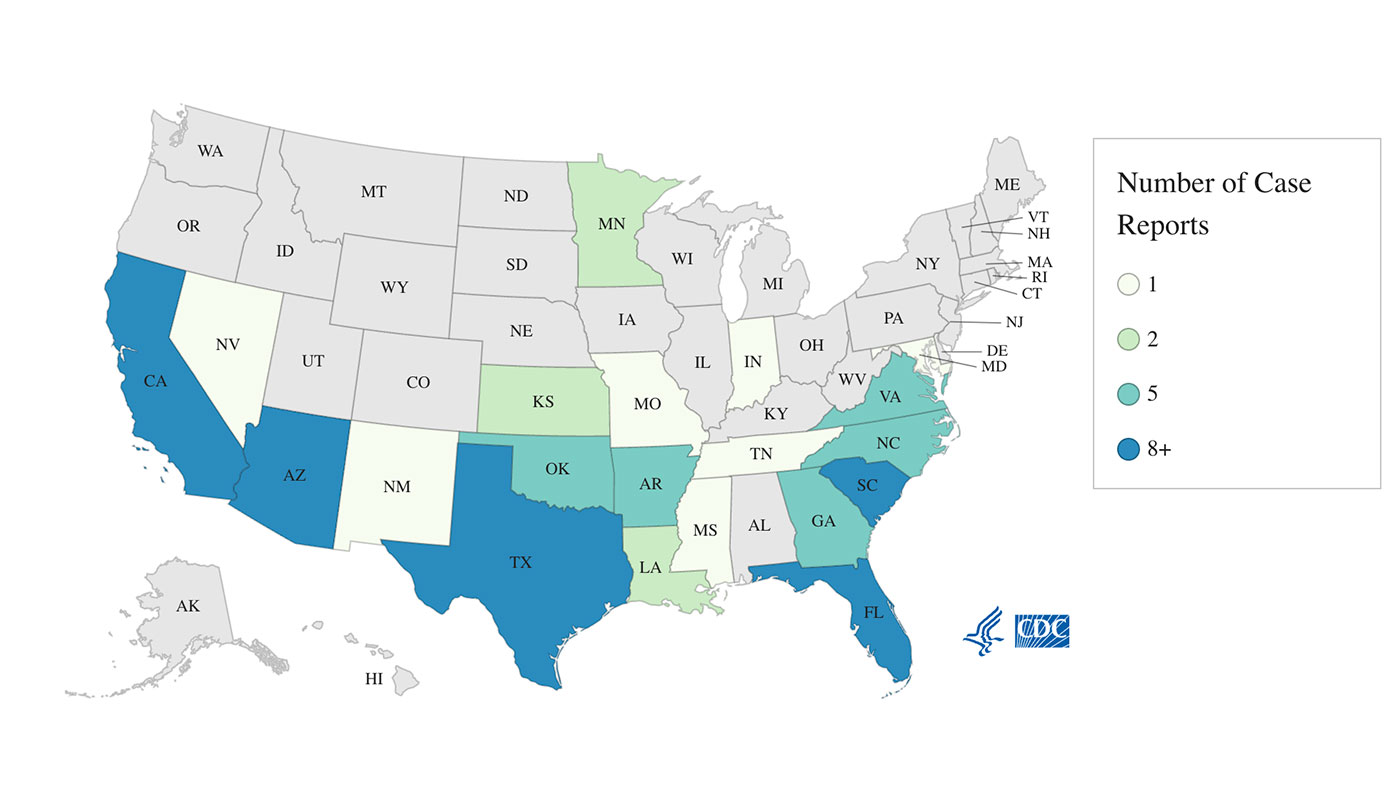In the summer time, when the mid-day heat hits it’s full peak, there’s nothing more refreshing than jumping in your favorite swimming hole. With murmurs of brain-eating amoebas in the news lately, even while having fun swimming you might be thinking in the back of your mind… is this safe?
We hear about these deadly amoebas around the U.S. when someone becomes infected and dies on the news. People who love lake life ask a lot of questions and search online every time there is a report. Since the news outlets do not give us enough information on brain eating amoebas. We have done some research to help you find out for sure what the risks of brain-eating amoebas are at your local lake or river.
What Are Brain-Eating Amoebas?
The U.S. and other countries do run into this serious amoeba health issue in water bodies, but the chances of contracting an infection from these BE amoebas are rare. Brain-eating amoebas love hot water. It grows best in and can survive in water as hot as 115 F.
Amoebas are single-celled organisms. The brain-eating amoeba’s scientific name is Naegleria fowleri (N. fowleri). It was discovered in 1965. It is typically present in warm freshwater bodies or untreated, contaminated waters.
The truth is that the N. fowleri is almost always deadly, but can only cause infection through the nose. The current statistics report there have been 154 cases in the U.S. between 1966 and 2022, and only four of the people infected have survived.
Where Have Brain-Eating Amoebas Been Found?
The brain-eating amoeba (BE amoebas), or Naegleria fowleri (N. fowleri), lives in warm freshwater, mostly in the Southern states in the U.S. and in other countries. Every year, a few swimmers in the US are hospitalized after contracting BE amoebas. The CDC has an online map of brain-eating amoeba locations.
Brain-eating amoebas have been found in 19 U.S. states. From Virginia to Florida, in all the southeastern seaboard states, GA, FL, NC, SC, and VA, in most of the southern states of AR, IN, KA, LA, MO, MS, OK, and TX, and in the southwestern and a couple northern states, AZ, CA, MN, NM, NV, and TX.

Naegleria fowleri can’t live in saltwater. It can’t survive in properly treated swimming pools or in properly treated municipal water. You also cannot get infected by drinking contaminated water. Most cases of N. fowleri disease occur in Southern or Southwestern states. Over half of all infections have been in Florida and Texas.
N. fowleri is found in:
- Warm lakes, ponds, and rock pits
- Mud puddles
- Warm, slow-flowing rivers, especially those with low water levels
- Untreated swimming pools and spas
- Untreated well water or untreated municipal water
- Hot springs and other geothermal water sources
- Thermally polluted water, such as runoff from power plants
- Aquariums
- Soil, including indoor dust
- Splash pads for children
- Water parks
What Happens When an Amoeba Eats Your Brain?
Doctors call this disease Primary Amebic Meningoencephalitis (PAM). N. fowleri is microscopic and only 8 micrometers to 15 micrometers in size, depending on its life stage and environment. By comparison, a hair is 40 to 50 micrometers wide.
When the brain-eating amoeba enters the human body, it causes a rare, deadly infection and inflammation in the brain, eventually destroys the brain tissue by “eating” it, which means it destroys healthy brain tissue. It can only enter through the nose.
N. fowleri reproduces by cell division, like all amoebas. When conditions aren’t right, the amoebas become inactive cysts. When conditions are favorable, the cysts turn into trophozoites, which are the feeding form of the BE amoeba that can destroy healthy brains.
The PAM infection is extremely rare, with 154 cases recorded in nearly 60 years of disease surveillance. The Centers for Disease Control and Prevention (CDC) has been tracking infections associated with the amoeba and states where people have been exposed to it since 1962.
Can Brain-Eating Amoebas Be Cured?
The N. fowleri has been a tough disease for doctors to cure. Since its discovery, 97% of patients who contracted BE amoebas died in the U.S.
Not often. Four people in the U.S. have survived brain-eating amoebas. The first person to survive them contracted them in 1978. Medical researchers theorize that the survivors that the original U.S. survivor’s strain of N. fowleri was less virulent, which contributed to the patient’s recovery.
Brain-Eating Amoeba Symptoms
In its early stages, symptoms of PAM may be similar to symptoms of bacterial meningitis. Initial symptoms of PAM start about 5 days, but can range from 1 to 12 days, after infection. The initial symptoms may include headache, fever, nausea, or vomiting. Later symptoms can include stiff neck, confusion, lack of attention to people and surroundings, loss of balance, seizures, and hallucinations. After the start of symptoms, the disease progresses rapidly and usually causes death within about 5 days, but can range from 1 to 18 days.
Brain Eating Amoeba Treatment
Primary Amebic Meningoencephalitis (PAM) is treated with a combination of drugs, often including amphotericin B, azithromycin, fluconazole, rifampin, miltefosine, and dexamethasone. These drugs are used because they are thought to have activity against Naegleria fowleri and have been used to treat patients who survived. Miltefosine is the newest of these drugs and has shown ameba-killing activity against free-living amebae, including Naegleria fowleri, in the laboratory.
We only know about the treatment that has helped four survivors in the U.S. From the CDC:
“During the summer of 2013, two children with Naegleria fowleri infection survived. The first, a 12-year-old girl, was diagnosed with PAM approximately 30 hours after becoming ill and was started on the recommended treatment of amphotericin B, fluconazole, rifampin, azithromycin, and dexamethasone within 36 hours. She also received the investigational drug miltefosine 7-9 and her brain swelling was aggressively managed with treatments that included cooling the body below normal body temperature (therapeutic hypothermia).
This patient made a full neurologic recovery and returned to school. Her recovery has been attributed to early diagnosis and treatment and novel therapeutics including miltefosine and hypothermia. A second child, an 8-year-old male, is also considered a PAM survivor, although he has suffered what is likely to be permanent brain damage. He was also treated with amphotericin B, fluconazole, rifampin, azithromycin, miltefosine, and dexamethasone but was diagnosed and treated several days after his symptoms began. Cooling of the body below normal body temperature was not used.”
Brain-Eating Amoebas in Texas
Texas and Florida have the most reported cases of brain-eating amoeba infection. As water temperatures rise, states will issue warnings that conditions are right for growth of N. fowleri, or that they detected N. fowleri. In June 2022, the Brazos River Authority issued a warning for N. fowleri because most of Texas is experiencing a drought, and our temperatures were beginning to rise higher than normal and conditions are right for the brain-eating amoeba growth.
Questions From Our Audience About Brain-Eating Amoebas
Should I worry about brain-eating amoebas?
No, but you should take precautions. If you live in states that have reported cases in the past, and the water temperatures of the lake you want to swim in are rising to the ideal growth temperature for brain-eating amoeba because the climate has been super hot, call your state fish, game, wildlife, conservation agency to check for warnings.
Is it safe for humans to swim?
Yes and no. Yes, it is almost always safe for humans to swim. No, it is not safe for humans to swim in water infected with brain-eating amoebas.
Is it safe for dogs to swim?
We don’t know. A few different animal species have been susceptible to brain-eating amoebas, but there have been no reported canine cases to date. PAM disease is extremely rare in people. A human is much more likely to get diagnosed than a dog, in which testing would be less common. It is not an easy infection to diagnose in humans, plus it would require testing of the dog’s brain after death. Most dogs that die of neurological disease do not get tested for N. fowleri. It is not a high-risk situation for dogs, but we just do not know.
I’ve read recently about someone getting a brain-eating amoeba after swimming in a lake. Can you explain the risk?
The risk comes when you are swimming and diving in water bodies infected with brain-eating amoebas that are extremely warm, brackish, slow-moving rivers, ponds, and lakes. Call your lake or river authority to check for warnings. The brain-eating amoeba enters through the nose. You can wear a nose clip to reduce the risk.







